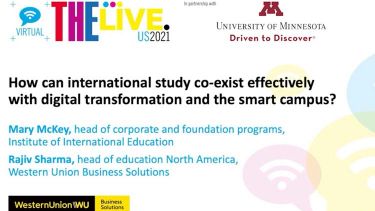Universities are working to personalise learning and entrench human interaction as the pandemic puts strain on international students
Consumers increasingly expect services that cater to their specific needs, and higher education is no exception. The Covid-19 pandemic has pushed universities online, forcing faculty and students to use technology to stay connected.
For international students, this digital push could help them to overcome the challenges posed by pre-pandemic university systems, according to panellists on Times Higher Education’s “Creating smart, sustainable campuses for international students” webinar, held in partnership with Western Union Business Solutions.
Students want a personalised experience that responds to their needs, said Skyler Webster, director of global product at Western Union Business Solutions. From chatbots that can translate many different languages to blended learning, technology could transform international students’ university experiences and address their unique problems.
“With international students, the biggest challenge is time zones,” Webster said. Travel restrictions mean that many students have been unable to leave their home countries, which has changed what they require from their lecturers and courses. “They want synchronous and asynchronous opportunities – they don’t want to be up at 3 o’clock in the morning [to attend a class].” They want flexibility built into their learning experience.
International students have forced institutions to examine the limitations of technology and to find innovative ways to address them – from the fact that people in some countries can’t access Google to the need for online security and firewalls. “Our international students have taught us and made us much better prepared and more future-ready,” Webster said.
In many ways, the move online has forced faculty to go back to the basics of teaching, said Robb Davis, director of intercultural programmes at the University of California, Davis: “You really thought about what it means to engage with students.” Sometimes this is on a basic pedagogical level, relating to how students actually learn, he added.
The Covid-19 pandemic has created an awareness that not all learning occurs in the classroom. “Learning is a social activity,” said Camille Rutherford, vice-provost international at Brock University in Canada. “This is one of the biggest gaps that we all took for granted [when Covid-19 struck and universities migrated online]. As you’re walking out of class, you bump into people and that’s how you get to meet people and meet new friends, especially for international students.”
To address this, the university has been focusing on systems that allow people to connect. Through gamification software Crowdpurr, the university hosts online events and encourages remote social interaction between students. It has also set up global peer communities using Microsoft Teams and has established a community of students in India who are now better able to engage with each other through this software. “Across the sector, we’ve got to be pragmatic about how we are building those human connections and those opportunities for students to connect with each other,” Rutherford explained.
The same goes for students connecting with faculty. The pandemic has not just highlighted international students’ current difficulties – from technology challenges to conflicting time zones – but has also shown that many historical systems need to be improved to properly engage with the needs of these students. “If an international [student] comes in with a regulatory issue, it’s also an opportunity to ask, ‘how are things going academically?’ and not just say, ‘you can now go talk to your academic adviser,” Davis said.
The panellists hoped that the lessons learned during the pandemic would not be forgotten once we return to face-to-face teaching. “We learned that trying new things would lead to some really cool innovations, could lead to better engagement with students,” Davis said. “If we’ve learned anything from the past 12 months, it’s that we need to try new things.”
Watch the Times Higher Education and WUBS webinar on-demand above or on the THE Connect YouTube channel.
Find out more about Western Union Business Solutions and higher education.




